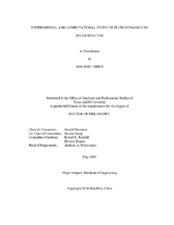| dc.contributor.advisor | Morrison, Gerald L | |
| dc.contributor.advisor | Ozalp, Nesrin | |
| dc.creator | Chien, Min-Hsiu | |
| dc.date.accessioned | 2015-01-09T20:24:52Z | |
| dc.date.available | 2016-05-01T05:31:03Z | |
| dc.date.created | 2014-05 | |
| dc.date.issued | 2014-02-19 | |
| dc.date.submitted | May 2014 | |
| dc.identifier.uri | https://hdl.handle.net/1969.1/152535 | |
| dc.description.abstract | The experimental simulation and a computational validation of a methane-cracking solar reactor powered by solar energy is the focus of this article. A solar cyclone reactor operates at over 1000 °C where the methane decomposition reaction takes place. Carbon particles are formed when methane molecules dissociate into carbon and hydrogen. During the course of this two-phase flow transport, part of the carbon particles tend to deposit on the inner surfaces such as the inner wall, window, and exit of the reactor. The deposition of carbon particles on the inner surfaces of the reactor blocks energy input and decreases converting efficiency. Particularly when they accumulate near the reactor exit, agglomeration of these particles tends to block the exit. In response to the unwanted deposition, a cyclone main flow provided a shield flow concept was predicted to prevent carbon deposition from the methane decomposition process via computational fluid dynamics (CFD). Based on the geometry of previous CFD studies an experimental validation to the effectiveness of the shield flows was performed via particle image velocimetry (PIV) and pressure sensitive paint (PSP) techniques. Three flow cases using air at atmospheric pressure, air at partial vacuum and mixture of different gas species at atmospheric pressure were used to simulate the flow interaction in the high temperature environment where methane cracking process occurs. The vortex structure in the reactor prolonged the resident time of the main flow in favor of higher energy conversion. The optimal resident time took place when the main flow decreased by 20 % compared to a reference CFD prediction. The resident time decreased when wall streams increase.
According to the experimental data obtained from the three flow cases, a CFD simulation was performed to validate the computational model. A high temperature case simulation was compared to the room temperature cases via CFD. The CFD results showed same flow pattern between high temperature case and room temperature cases. By experimental and computational approaches, this article provides a thorough analysis to the future design and study of the solar cyclone reactors. | en |
| dc.format.mimetype | application/pdf | |
| dc.language.iso | en | |
| dc.subject | Solar Reactor, PIV, PSP, CFD | en |
| dc.title | Experimental and Computational Study of Fluid Dynamics in Solar Reactor | en |
| dc.type | Thesis | en |
| thesis.degree.department | Mechanical Engineering | en |
| thesis.degree.discipline | Mechanical Engineering | en |
| thesis.degree.grantor | Texas A & M University | en |
| thesis.degree.name | Doctor of Philosophy | en |
| thesis.degree.level | Doctoral | en |
| dc.contributor.committeeMember | Ranjan, Devesh | |
| dc.contributor.committeeMember | Randall, Robert E | |
| dc.type.material | text | en |
| dc.date.updated | 2015-01-09T20:24:52Z | |
| local.embargo.terms | 2016-05-01 | |
| local.etdauthor.orcid | 0000-0002-2907-2089 | |


